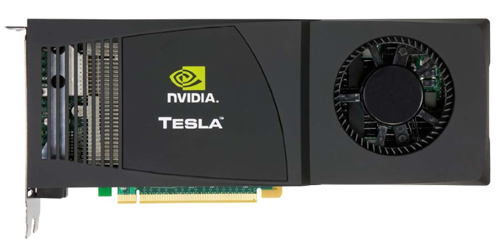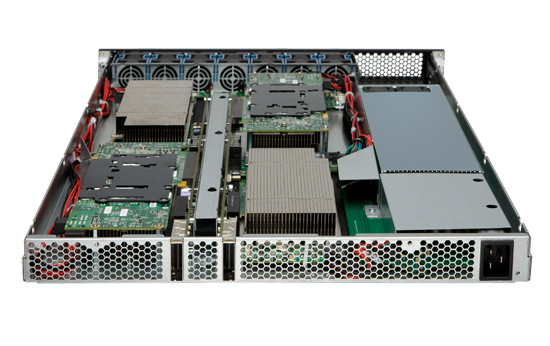NVIDIA's Fermi: Architected for Tesla, 3 Billion Transistors in 2010
by Anand Lal Shimpi on September 30, 2009 12:00 AM EST- Posted in
- GPUs
A Different Sort of Launch
Fermi will support DirectX 11 and NVIDIA believes it'll be faster than the Radeon HD 5870 in 3D games. With 3 billion transistors, it had better be. But that's the extent of what NVIDIA is willing to talk about with regards to Fermi as a gaming GPU. Sorry folks, today's launch is targeted entirely at Tesla.

A GeForce GTX 280 with 4GB of memory is the foundation for the Tesla C1060 cards
Tesla is NVIDIA's High Performance Computing (HPC) business. NVIDIA takes its consumer GPUs, equips them with a ton of memory, and sells them in personal or datacenter supercomputers called Tesla supercomputers or computing clusters. If you have an application that can run well on a GPU, the upside is tremendous.

Four of those C1060 cards in a 1U chassis make the Tesla S1070. PCIe connects the S1070 to the host server.
NVIDIA loves to cite examples of where algorithms ported to GPUs work so much better than CPUs. One such example is a seismic processing application that HESS found ran very well on NVIDIA GPUs. It migrated a cluster of 2000 servers to 32 Tesla S1070s, bringing total costs down from $8M to $400K, and total power from 1200kW down to 45kW.
| HESS Seismic Processing Example | Tesla | CPU |
| Performance | 1 | 1 |
| # of Machines | 32 Tesla S1070s | 2000 x86 servers |
| Total Cost | ~$400K | ~$8M |
| Total Power | 45kW | 1200kW |
Obviously this doesn't include the servers needed to drive the Teslas, but presumably that's not a significant cost. Either way the potential is there, it's just a matter of how many similar applications exist in the world.
According to NVIDIA, there are many more cases like this in the market. The table below shows what NVIDIA believes is the total available market in the next 18 months for these various HPC segments:
| Processor | Seismic | Supercomputing | Universities | Defence | Finance |
| GPU TAM | $300M | $200M | $150M | $250M | $230M |
These figures were calculated by looking at the algorithms used in each segment, the number of Hess-like Tesla installations that can be done, and the current budget for non-GPU based computing in those markets. If NVIDIA met its goals here, the Tesla business could be bigger than the GeForce one. There's just one problem:
As you'll soon see, many of the architectural features of Fermi are targeted specifically for Tesla markets. The same could be said about GT200, albeit to a lesser degree. Yet Tesla accounted for less than 1.3% of NVIDIA's total revenue last quarter.
Given these numbers it looks like NVIDIA is building GPUs for a world that doesn't exist. NVIDIA doesn't agree.
The Evolution of GPU Computing
When matched with the right algorithms and programming efforts, GPU computing can provide some real speedups. Much of Fermi's architecture is designed to improve performance in these HPC and other GPU compute applications.
Ever since G80, NVIDIA has been on this path to bring GPU computing to reality. I rarely get the opportunity to get a non-marketing answer out of NVIDIA, but in talking to Jonah Alben (VP of GPU Engineering) I had an unusually frank discussion.
From the outside, G80 looks to be a GPU architected for compute. Internally, NVIDIA viewed it as an opportunistic way to enable more general purpose computing on its GPUs. The transition to a unified shader architecture gave NVIDIA the chance to, relatively easily, turn G80 into more than just a GPU. NVIDIA viewed GPU computing as a future strength for the company, so G80 led a dual life. Awesome graphics chip by day, the foundation for CUDA by night.
Remember that G80 was hashed out back in 2002 - 2003. NVIDIA had some ideas of where it wanted to take GPU computing, but it wasn't until G80 hit that customers started providing feedback that ultimately shaped the way GT200 and Fermi turned out.
One key example was support for double precision floating point. The feature wasn't added until GT200 and even then, it was only added based on computing customer feedback from G80. Fermi kicks double precision performance up another notch as it now executes FP64 ops at half of its FP32 rate (more on this later).
While G80 and GT200 were still primarily graphics chips, NVIDIA views Fermi as a processor that makes compute just as serious as graphics. NVIDIA believes it's on a different course, at least for the short term, than AMD. And you'll see this in many of the architectural features of Fermi.










415 Comments
View All Comments
Zingam - Thursday, October 1, 2009 - link
Perhaps next gen consoles would be C++ based and not API based (what a great terminology). So in that sense DirectX won't matter like it won't matter on Larrabee because it will be emulated in software. Larrabee would not have any silicon dedicated to OpenGL or DirectX I think.Once GPUs get fast enough I guess they won;t be called Graphics processors anymore and will support APIs as software implementations.
marc1000 - Thursday, October 1, 2009 - link
well, perhaps... I was searching the web yesterday for info on the new consoles, it was kinda sad. if we do not get a new minimun-standard (a powerful console), then the PC games will not be that hard to run on PCs... then my old Radeon 3850 is still capable of running almost ALL games with "good enough" permformance (read: average 30-50fps on most of the console ports to PC).and so: no reason to upgrade! :-(
Dobs - Wednesday, September 30, 2009 - link
Personally I think Eyefinity will be remembered as the master stroke as well as first to implement DirectX 11. Nvidia may get 10 fps more in DirectX 11 in Q2 2010 but will still struggle until it has it's own version of Eyefinity.Current uber-cool for the cashed-up is Eyefinity and once you have 3 or 6 monitors you will only buy hardware that will support it. These 'cashed-up' PC gamers are usually Nvidia's favorite customers.
Nvidia needs flexible wrap-around OLED mega resolution monitors to come out yesterday, but I'm pretty sure that didn't happen... 5850 which supports 3 monitors came out yesterday. :P
SiliconDoc - Thursday, October 1, 2009 - link
Nvidia has supported FOUR monitors on say for instance, the 570i sli, for like YEARS dude.Just put in 2 nv cards, plug em up - and off you go, it's right in the motherboard manuals...
Heck you can plug in two ati cards for that matter.
---
Anyway on the triple monitor with this 5870/50, the drivers are a mess, some having found the patch won't be for a month, then the extra $100 cable is needed, too, as some have mentioned, that ati has not included.
They're pissed.
Dobs - Thursday, October 1, 2009 - link
I'll be avoiding the extra $100 cable by getting DisplayPort monitors from the start. Also want to get ips monitor (i think) so that it will support the portrait mode.If I already had 3 non-DisplayPort monitors, I wouldn't mind shelling out for the DisplayPort adapter if that was my only expense. But if the adapter was flakey I'd be upset as well. I know multi-monitors have been around for years, but they've never been this easy to set-up... Even I could do it :P And the drivers will get better in time, and no doubt future games will look to include Eyefinity as well.
SiliconDoc - Thursday, October 1, 2009 - link
Well I do hope you have good luck and that you and your son enjoy it ( no doubt will if you manage get it), and it would be nice if you can eventually link a pic (likely in some future article text area) just because.I think eyefinity has an inherent advantage, cheaper motherboard possible, 3 on one card, and with 3 from the same card, you can have the concave wrap view going with easy setup.
I agree however with the comment that it won't be a widely used feature, and realize most don't even use both monitor hookups on their videocards that are already available as standard, since long ago, say the 9600se and before.
(I use two though, and I have to say it is a huge difference, and much, much better than one)
yacoub - Wednesday, September 30, 2009 - link
Wake up: 99% of people don't give a crap about Eyefinity. Not only do the VAST, VAST majority of customers have just one display, but those who do have multiple ones (like myself) often have completely different displays, not multiple of the same model and size. And then, even when you find that 0.1% of the customer base that has two or more identical monitors side-by-side, you have to find the ones who game on them. Then of those people, find the ones who actually WANT to have their game screen split across two monitors with a thick line of two display borders right in the middle of their image.Eyefinity is relevant to such an infinitesimally small number of people it is laughable every time someone mentions it like it's some sort of "killer app" feature.
Jamahl - Thursday, October 1, 2009 - link
thats why eyefinity has millions of youtube views already right.yacoub - Thursday, October 1, 2009 - link
because purchases are measured in YouTube views. wow, just... wow.ClownPuncher - Thursday, October 1, 2009 - link
It clearly means people are interested enough to look. Wow, just...wow.You don't like it, other people do. Get over it.